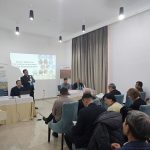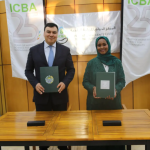On May 27, this year, a meeting was held with Haruyuki Fujimaki, Professor at the Arid Lands Research Center (Tottori University, Japan). The purpose of the visit of Professor Haruyuki Fujimaki is to test the innovative method of drip irrigation in the arid lands of the Republic of Karakalpakstan.

Meeting with Professor Haruyuki Fujimaki
As we know, furrow irrigation is widely practiced in the Aral Sea basin. This can lead to a large loss of evaporation and associated with the accumulation of salt at the surface of the soil. According to Professor Haruyuki Fujimaki, by introducing drip irrigation, we can significantly save water and mitigate the associated salt accumulation. One of the drawbacks of drip irrigation is that salts accumulate when wet in the soil surface, and they cannot be removed by drip irrigation itself. By attaching a cotton non-woven sheet, salts near the soil surface can be collected and removed by removing the sheet.
The purpose of this experiment is to study:
- how much water can be saved by introducing drip irrigation downstream of the Amu Darya River.
- how much salt can be removed using a sheet to remove salt.
This experimental work is being carried out at the Samanbay Scientific and Production Site of the International Innovation Center for Aral Sea Basin.
According to Professor Haruyuki Fujimaki, this innovative technology increases the efficiency of water use and the management of drip irrigation with respect to salinization.

Preparation of necessary materials for the experiment

Preparation of the experimental site

Preparation of the experimental site

Planted corn seeds in pots for the experiment

Pipe installation for drip irrigation

























